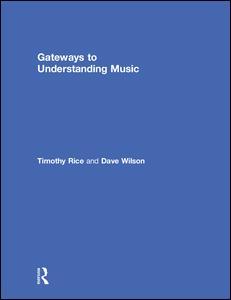Gateways to Understanding Music
Auteurs : Rice Timothy, Wilson Dave

Gateways to Understanding Music explores music in all the categories that constitute contemporary musical experience: European classical music, popular music, jazz, and world music. Covering the oldest forms of human music making to the newest, the chronological narrative considers music from a global rather than a Eurocentric perspective. Each of sixty modular "gateways" covers a particular genre, style, or period of music. Every gateway opens with a guided listening example that unlocks a world of music through careful study of its structural elements. Based on their listening experience, students are asked to consider how the piece came to be composed or performed, how the piece or performance responded to the social and cultural issues at the time and place of its creation, and what that music means today. Students learn to listen to, explain, understand, and ultimately value all the music they may encounter in their world.
FEATURES
- Global scope?Presents all music as worthy of study, including classical, world, popular, and jazz.
- Historical narrative?Begins with small-scale forager societies up to the present, with a shifting focus from global to European to American influences.
- Modular framework?60 gateways in 14 chapters allow flexibility to organize chronologically or by the seven recurring themes: aesthetics, emotion, social life, links to culture, politics, economics, and technology.
- Listening-guided learning?Leads to understanding the emotion, meaning, significance, and history of music.
- Introduction of musical concepts?Defined as needed and compiled into a Glossary for reference.
- Consistent structure?With the same step-by-step format, students learn through repeated practice how to listen and how to think about music.
In addition to streamed audio examples, the companion website hosts essential instructors? resources.
Introduction / Part I Music History to 1500 / Chapter 1 Music of Small-Scale Societies / Chapter 2 Ancient and Medieval Religious Music / Chapter 3 Ancient and Medieval Secular Music / Part II Music History from 1500 to 1900 / Chapter 4 Music from the European Age of Discovery (1500-1600) /Chapter 5 Music from the Age of Global Commerce (1600-1750) /Chapter 6 Music from the Age of Enlightenment and Revolution (1750-1800) / Chapter 7 Music from the Early Nineteenth Century (1800-1850) /Chapter 8 Music from the Late Nineteenth Century (1850-1900) / Part III Music History during the Long Twentieth Century / Chapter 9 Music from the Turn of the Twentieth Century (1890-1918) /Chapter 10 Music from the Interwar Period (1918-1939) /Chapter 11 Music during World War II and its Aftermath (1939-1950) / Chapter 12 Music from an Age of Disenchantment and Protest (1950-1975) / Chapter 13 Music and Community (1975-1994) / Chapter 14 Music Today / Where Do We Go from Here?
Timothy Rice is Distinguished Professor, Emeritus, and founding director of the University of California, Los Angeles (UCLA) Herb Alpert School of Music.
Dave Wilson is Lecturer in Music at Victoria University of Wellington, New Zealand.
Date de parution : 01-2019
21x28 cm
Disponible chez l'éditeur (délai d'approvisionnement : 14 jours).
Prix indicatif 196,56 €
Ajouter au panierDate de parution : 01-2019
21x28 cm
Disponible chez l'éditeur (délai d'approvisionnement : 14 jours).
Prix indicatif 99,36 €
Ajouter au panierThème de Gateways to Understanding Music :
Mots-clés :
Von Bingen; Wolfgang Amadeus Mozart; music appreciation; Mozart; general education music; Country Music; nonmajor; Symphonie Fantastique; music history; Clair De Lune; music making; Gamelan Gong Kebyar; gateways; Buffalo Soldier; classical music; Alamy Stock Photo; jazz; European Classical Music; world music; Chopin; popular music; Los Tigres Del Norte; diversity; Sicut Cervus; Thelonious Monk; North Indian Classical Music; Tin Pan Alley; Habanera Rhythm; Wikimedia Commons; Maple Leaf Rag; Wah Wah Pedal; La Negra; Tan Fantasy



